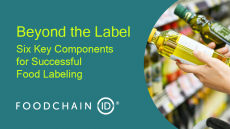Food manufacturers call for risk/benefit analysis on acrylamide
activities on acrylamide, a harmful chemical recently identified in
carbohydrate-rich foods, conclude stakeholders after a recent
meeting in Brussels,reports Lindsey Partos.
Under the aegis of the European Commission, participants from the European Food Safety Authority, the European research project 'Heatox', the Confederation of Food and Drink Industries (CIAA) and consumer group BEUC, and other stakeholders, gathered to discuss measures to reduce acrylamide levels in food.
In April 2002, acrylamide came to the attention of the food industry when scientists at the Swedish Food Administration first reported unexpectedly high levels in fried, baked, grilled, toasted or microwaved carbohydrate-rich foods, for example chips, roast potatoes, crisps and bread.
Since then, an international effort means that more than 200 research projects have been initiated around the world with their findings co-ordinated by national governments, the European Union and the United Nations.
At the meeting in January, the CIAA, that represents the €600 billion European food and drink industry, won support for its "toolbox" of parameters: these show the potential for reduction in acrylamide levels by controlling agronomic factors, product composition and process controls.
The "toolbox" parameters will be helped by a breakthrough in efforts to understand the creation of acrylamide in foods, that came in late 2002 through research led by Professor Don Mottram at the University of Reading.
Mottram's team suspected it could be created by a reaction between an amino acid called asparagine, which occurs naturally in relatively high levels in potatoes and other cereals, and sugar.
Tests confirmed that when the amino acid is heated, it does react with sugar to create acrylamide, a process called the Maillard reaction. This occurs at temperatures above 100°C (212°F). Their findings were published in Nature 419, 448-449 (2002).
Speaking last year to FoodNavigator.com Professor Mottram confirmed that the industry is still working to look at empirical ways to gauge the problem.
But taking into account strategies to cut the acrylamide content in foods, stakeholders at the Commission-led meeting in January voiced their concerns that suggested routes of minimisation could potentially have other effects on the nutritional quality, fat content et al of foods.
In a bid to tackle their concerns, participants at the meeting supported a risk/benefit analysis to provide a clearer view of the impact on food formulation.
Last month the UN's Joint FAO/WHO Expert Committee on Food Additives (JECFA) also held a meeting to assess developments in acrylamide.
Conclusions drawn by the committee include: that work should continue using Physiologically-based Pharmacokinetic (PBPK) modelling to better link human biomarker data with exposure assessments and toxicological effects in experimental animal.
Evidently, the committee highlighted that appropriate efforts to reduce acrylamide concentrations in food should continue; and that acrylamide should be re-evaluated when results of ongoing carcinogenicity and longterm neurotoxicity studies become available.















